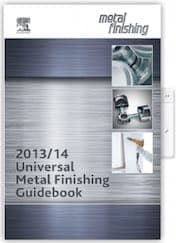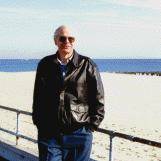
Curated with aloha by
Ted Mooney, P.E. RET

The authoritative public forum
for Metal Finishing 1989-2025

-----
Wood's Nickel Strike?
Q. Maybe this question seems strange, but could you be so kind and explain me what the "Wood's nickel strike" is? I suppose it's a chloride bath with low pH, but I'm not sure. Thanks in advance.
Adam Wittmann- Poland
1999
sometimes on
AbeBooks or Amazon
(affil links)

free pdf is currently available from academia.edu
A. Not at all strange, Adam:-)
Stainless steel, and nickel itself, are very difficult to properly plate onto because of their natural passivity. Don Wood (deceased) developed a combination activator/strike bath for the purpose. As you surmised, it's a nickel chloride bath at low pH. Specifically, per the Metal Finishing Guidebook, it's:
- Nickel chloride 16-64 oz/gal.
- Hydrochloric acid 8-32 fl oz/gal (with a 1:1 ratio of nickel chloride to hydrochloric acid recommended)
- Room temperature
- Start work anodically at 10-20 ASF for 2 minutes, then plate at 20-200 ASF for 1-4 minutes (although not everyone starts with that anodic cycle).
More detail can be found in the Guidebook. Good luck.

Ted Mooney, P.E.
Striving to live Aloha
finishing.com - Pine Beach, New Jersey
Q. Can you translate your units to metric please.
rayde- Glasgow, Scotland
July 29, 2024
Tip: This forum was established to build camaraderie among enthusiasts through sharing tips, opinions, pics & personality.
The curator & some readers who publicly share their info will be less likely to engage with those who don't.
A. Hi.
Although metric units are usually better, I love the simplicity of Robert Probert's suggested formulation: 2 qt/gal HCl, 2 lb/gal NiCl :-)
2 quarts HCl per gallon = 64 fl oz/gal X 7.81 = 500 ml/l
2 lb Nickel chloride per gallon = 32 oz/gal / 0.134 = 239 g/l
20-200 ASF x 0.108 = 2.2-21 Amps/dm2
Luck & Regards,

Ted Mooney, P.E. RET
Striving to live Aloha
finishing.com - Pine Beach, New Jersey
A. Wood's Nickel strike
Hydrochloric acid 8-10 % by vol.
Nickel chloride 25-35 oz/gal
Cathodic Current 2000 amps per 30-40 sq.ft.
Time to plate 2-3 minutes
You can plate Stainless Steel parts.
Before you plate need activation.
Electroplate consultant - Sterling Heights
Q. I just recently started using Wood's nickel strike and I must say my results are nothing short of spectacular! I had been using another product. So my question is, is the Wood's nickel strike made from a particular company or is that name just a catch-all name for that particular mixture? I hope this doesn't seem like a stupid question. Thanks, I have a lot of time on my hands.
Richard Courtright- San Francisco California USA
November 23, 2014
A. Hi Richard. It was invented/developed by Don Wood (dec.) of Hill-Cross Company [a finishing.com supporting advertiser], but has been generic for a very long time now. It contains nothing but nickel chloride and hydrochloric acid -- nothing proprietary.
Regards,

Ted Mooney, P.E.
Striving to live Aloha
finishing.com - Pine Beach, New Jersey
Q, A, or Comment on THIS thread -or- Start a NEW Thread